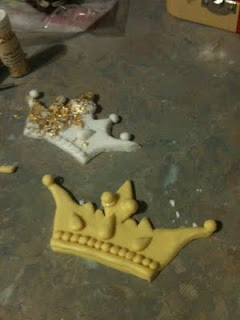Jamie Oliver, Martha Stewart, Chantal Coady all had chocolate tart recipes but I was looking for something very specific. In the end I adapted elements from all of them... this double chocolate tart has bitter cocoa in the pastry and 70% semisweet chocolate in its ganache filling.
 I also made little tartlets. These little babies are bite size and they're small enough for even people on horrible DIETS to consume.
I also made little tartlets. These little babies are bite size and they're small enough for even people on horrible DIETS to consume.  Recipe is below, but here's the pictorial version...
Recipe is below, but here's the pictorial version...The pastry is easy - all the dry ingredients get chucked in a food processor with the butter.
Then you add the iced water and pulse to make a ball of dough. You need to press this out roughly and wrap in cling film and chill for a while, because otherwise it's too hard to work.
 Butter the tart tins...
Butter the tart tins...When it's chilled, roll out - for small tartlets, cut a shape a slightly bigger circumference to the tin and push the pastry in, like in this pic, trimming the edges with a sharp knife.
For a larger tart, carefully pick up the rolled-out pastry and drape it centrally over the tin, then press it over the bottom and sides. Trim the edges with a sharp knife and use this extra pastry to patch any tears or gaps.
You should end up with something like this.
Blind bake the shells (instructions below) - these are what the tiny tart shells looked like when blind baked.
Make the ganache by boiling the cream and pouring it onto the chocolate pieces. With a few minutes of gentle stirring you will end up with a luscious, glossy mixture.
If you like, you could put a layer of something crunchy underneath the ganache - I say this because I used amazing stuff called Charlie's Choc Sugar, made by a company called Gewurzhaus. It's spicy, crunchy, and very sweet - the ingredients are cane sugar, cassia, coriander, clove, nutmeg and cocoa. Just adds something unexpected :-)
Fill the tart shells (with or without Charlie's Choc Sugar!) with the still-warm ganache and leave to cool.
By this stage you'll be getting a great sense of achievement, because the glossy ganache makes the tarts look wonderful!
Decorate with your choice of topping... I found these beautiful bi-colour chocolate curls in an amazing new providore Bottega Rotolo in Bathurst St Hobart.
They taste yummy too :-)
For the larger tart a big dollop of cream just provided a bit more contrast.
Happy eating, chocophiles.... full recipes below.
Chocolate Pate Brisee (Sweet Crust Pastry)
1 cup plain flour
1/4 cup cocoa
1 tsp salt
2 tsp granulated sugar
1/2 cup unsalted butter
1/4 to 1/2 cup iced water
Process all the dry ingredients and the butter (cut into small pieces) in a food processor for about 10 seconds, or until the mixture looks like coarse meal or breadcrumbs. Then pour a small amount of the iced water down the funnel while blitzing the mixture again. Add this slowly because you won't need it all. When the mixture balls cleanly from the sides of the processor, you have finished. Discard any water left over and turn the mixture out onto some cling wrap, flattening it into a rough circle with your palm. Then put it in the fridge for half an hour (or the freezer for 10 mins) to chill.
Grease and flour your tart tin/s and set the oven to 190C.
Flour your bench and rolling pin and roll out the pastry, turning it regularly to make sure it doesn't stick to the bench. Don't overwork it. When it's about 4mm thick, line the tart tins as shown above.
You need to blind bake the pastry shell (this means you put the pastry in the oven and cook it without a filling - you need to do this when the filling you are going to use doesn't need to be cooked). Spread a layer of baking paper over the pastry and use pastry weights, if you have them, or gravel or small stones if you don't, to weight it down (this will stop the pastry puffing up when cooking).
Bake a large shell for 15 mins or until it's slightly springy to the touch. Bake small/mini shells for about 8-10 mins; instead of using pastry weights, you can 'nest' another shell on top of them when cooking (like when you're stacking the empty tart tins on top of each other). This will stop them puffing up just as well as pastry weights.
When the tart shells are cooked, turn them out of the tins CAREFULLY and leave to cool while you make the ganache filling.
Ganache Filling
300ml thick cream
330g 70% dark chocolate
2 tsp castor sugar
Chop or break the chocolate into small pieces, place in a heatproof bowl and leave aside. Turn the cream and sugar into a small saucepan and bring it to the boil (be careful, when it starts to boil it will boil up and spill over very quickly). As soon as it boils, pour it onto the chocolate, and stir gently while the chocolate melts. After a few minutes the mixture should be well combined, thick and glossy.
To put it all together, spoon the still-warm ganache into the tart shells and leave it to cool.
















































